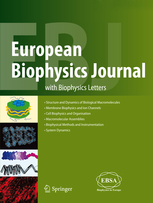VEGA 2/0095/15
Expression and co-localization of dyadic protein complexes in ventricular myocytes in relation to excitation-contraction coupling ontogenesis
Principal Investigator: Alexandra Zahradníková, jr.Duration: January 2015 – December 2017
|
Annotation:Excitation-contraction coupling in ventricular myocytes is based on calcium signalling in dyads – specialized junctions of sarcolemma and terminal cisternae of sarcoplasmic reticulum. The relationship between the molecular structure of dyads and the functionality of calcium signalling is not sufficiently understood, since its direct experimental manipulation is not possible. It should be possible to observe correlation between the structure and function of dyads during the postnatal stage of cardiac development, a period of their extensive formation and growth. The aim of the project is to correlate the changes in local calcium signalling to protein composition and interaction in individual dyadic complexes during myocyte ontogenesis. The acquired data will allow us to formulate hypotheses about the relationship between the structure and function of dyads at the molecular level and will help us understand the adaptive processes, occurring during cardiac hypertrophy, at the level of calcium signaling. |
Keywords:E-C coupling, calcium signalling, protein interaction, dyadic complexes |
Objectives:The aim of the project is to characterize the formation and growth of dyadic complexes during maturation of ventricular myocytes from the aspect of molecular biology in correlation with the development of E-C coupling at the level of individual dyads. We will focus on proteins that play a role in formation and structural stability of dyadic complexes (junctophillin, caveolin), signal transduction between surface and intracellular membranes (DHPR and RyR channels, Na/Ca exchanger) and on proteins regulating the communication between the channels of surface and intracellular membranes (calmodulin, junctin, triadin and calsequestrin). The questions we pose are: 1. How does expression of individual proteins of the dyadic complexes change during maturation of ventricular myocytes? 2. How do the changes in expression and localization of individual proteins of dyadic complexes relate to the development of the tubular system of the myocytes? 3. In what way do the observed changes correlate with the changes of E-C coupling? The results will provide original information about the relationship between the composition and arrangement of molecular complexes and the efficiency of calcium signalling in the process of excitation-contraction coupling. |
Publications: |
 |
Skrabanek P, Zahradnikova A Jr (2019): Automatic assessment of the cardiomyocyte development stages from confocal microscopy images using deep convolutional networks. PLoS One 14: e0216720, doi: 10.1371/journal.pone.0216720. |
 |
Mackova K, Zahradnikova A Jr, Hotka M, Hoffmannova B, Zahradnik I, Zahradnikova A (2017). Calcium release-dependent inactivation precedes formation of the tubular system in developing rat cardiac myocytes. Eur Biophys J 46: 691-703. |

 contact
contact
